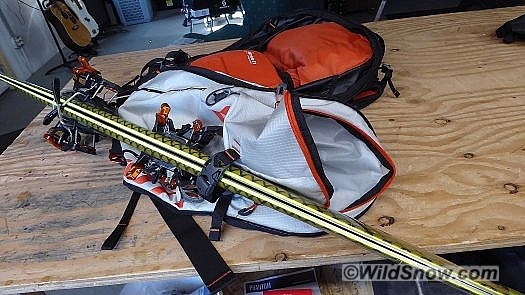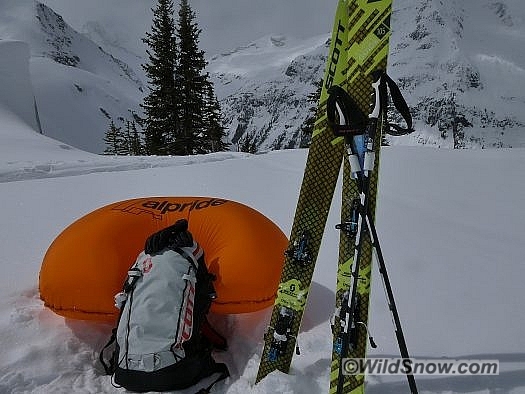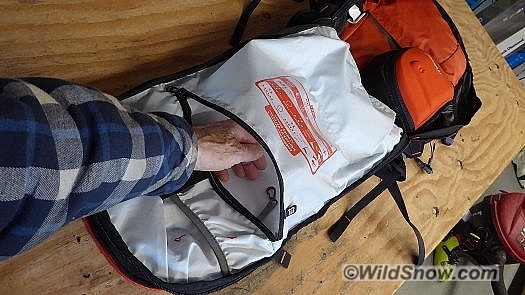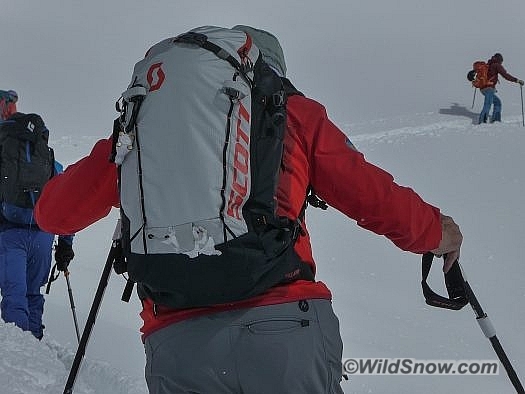Dick Jackson
I had the opportunity to field test the new Scott/Alpride 30 liter electric airbag pack (the AP 30) with “capacitor” system E1 while on a recent trip to the Battle Abbey Hut up in British Columbia’s Selkirk Range. To reference the comprehensive technical E1 review that Wildsnow offered back in February of this year, all the specs and statistics around this 30-liter pack are confirmed with the use of the Scott AP 30 in the field. This review thus emphasizes actual field use, rather than the electronic airbag system technical details.
Let’s first look at this pack from a practical perspective specific to its weight, capacity and comfort. At under six pounds and claimed 30-liter capacity (accurate, in my experience), this rucksack truly satisfies the needs for a single day ski tour.
An easy way to reach small items is often a downfall of ski packs, in regards to quick access during transitions and rest breaks on the skin track. No problem here, the AP 30 is well organized, with ample room in the top external “brain” compartment for goggles, sunglasses, and phone/camera and other accessible necessities. A tool compartment is there as well (accessed from the interior). A smaller zippered envelop compartment is layered on the tool compartment inside the main compartment, by way of providing more cargo organization. (All the interior layers could easily be scissored out you like the “one compartment” style backpack). The airbag trigger can be swapped to the zippered compartment on either left or right shoulder strap. You can route a hydration through the strap you don’t use for the trigger.
Since the guts of the E1 airbag system are so compact, the available main/cargo compartment is entirely sufficient for extra clothing, food, hydration, ski crampons, cordelette, FA/Repair/Snow study kits, and more. All efforts have been made and successfully integrated into this lightweight package with the choice of materials, right down to the accessory gear and ice tool loops with minimal straps for compression and ski carrying options; yet with thoughtful reinforcement on obvious high stress areas. The non-padded waist belt and snow shedding back panel are also ideal.
The AP 30 shovel/probe sleeve is spacious enough to accommodate a probe along with any standard shovel blade/shaft. I tend to place my climbing skins into the tool area, and doing so works fine with this pack as well. I would like to see an improved hook-loop closure over the tools to avoid spill/overflow since this panel opens fully to access the cargo area, better closure is especially needed with a longer probe. Most components and hardware are consistent with high quality materials and construction, although I’d like to see the main compartment zipper being a stronger/heavier grade to accommodate aggressive handling. I wouldn’t be surprised if that upgrade is present in the retail version.
I enjoyed the impressive fit and comfort the AP 30 pack offered while fully “unlocked and loaded.” As a mountain guide my choice for a ski pack has always been a critical priority, and I am pleased to acknowledge that this will definitely be on my back next winter. It rides as good or better than any other pack I’ve owned.
One thing about airbag backpacks, that’s always worth attention, is how the waist belt and leg loop operate. With the AP 30, I would suggest the leg loop attachment be altered to something similar to the “clip” built into another brand’s electric airbag system. In lieu of that, the leg loop can be rigged with a mini carabiner to clip the waist strap — anything but the tedious process of threading the waist belt through the leg loop.
Now let’s get into the features that we all appreciate in the “ideal” avalanche airbag pack…. that of course being the field use of the system itself. Number one question: Ease of travel and getting it through TSA without an anticipated hassle!? No worries… remove the AA batteries just to be sure, then just check it in or carry it on. Having read the WildSnow technical review, my initial enthusiasm was understandably at a high level as I committed to a week of ski touring in an impressive four meter Selkirk snowpack (at 2200m). Due to working with the company in both retail as well as product testing, I’m a strong proponent of Scott equipment… skis, boots, poles, goggles, gloves… likewise, my expectations were matched nearly 100% when I compared the Scott to other airbag systems I have used over many years now. I found the equivalent performance and recharging rate whether deployed at 70+ degrees inside the hut, or during full-on winter conditions while touring. It is hard to believe that just two lithium AA batteries would recharge the capacitors in the “claimed” 40 minutes, yet that is precisely the results that I got repeatedly during our week long outing.
Prior to the trip I charged the capacitors with the USB port, yet my confidence was heightened with repeated recharges using only the AA cells. Another pleasant surprise was the ease of deflating and repacking the balloon, even in the field with full winter conditions adding a reality check to my comfy indoor testing. Repacking the bag in the designated balloon compartment and the reliability of the birthing zipper were equally user-friendly. Even the top “haul” strap on the pack is well placed, to avoid the not uncommon mistake of grabbing the pack and unintentionally opening the airbag zipper.
The ski carrying lower cable and upper strap work for diagonal carry (upper and lower loops are mated so tensioning has a good cinching effect), but the system is clearly designed for lighter skis. To avoid excessive wobble and sway of skis I attached a ski strap to the upper side compression strap to stabilize the load. You could also attach a tensioning strap to the haul loop, except doing so is dangerous as it entirely blocks airbag deployment. In the end, what’s necessary and I’d hope to someday see is for the upper diagonal ski carry strap/loop to extend through the inside of the pack body, under the airbag, and anchor to near the shoulder strap attachments. Otherwise there’s no physical way for the system to totally eliminate ski sway, without excessive tension on the pack body zippers.

Diagonal carry system, upper strap needs a more secure attachment that doesn’t depend on the zippers. This is not an uncommon issue with any brand, and often a difficult design challenge.
Conclusion:
I can promote the AP 30 E1 as a ski pack, regardless of the fact that it’s also a terrific airbag pack. While I’m hesitant to use the phrase “game changer” before a product gets full retail consumer treatment, the term will likely apply. Scott Alpride AP 30 E1 will be available in retail this fall.
(Guest blogger Dick Jackson is an IFMGA Mountain Guide. Founder: School of Hard Knocks, as well as Aspen Expeditions.)
Beyond our regular guest bloggers who have their own profiles, some of our one-timers end up being categorized under this generic profile. Once they do a few posts, we build a category. In any case, we sure appreciate ALL the WildSnow guest bloggers!






